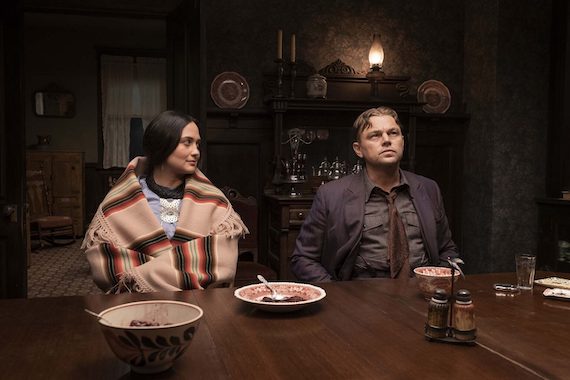Former Osage chief says film will force state to come to terms with its troubled past
The Friday release of the film that shines a spotlight on that dark chapter in Oklahoma will force a deeper conversation about the state coming to terms with its past, said former Osage Nation Principal Chief Jim Gray.
“This history’s been buried just like the Black Wall Street massacre,” he said. “There’s a lot of unfortunate events that have happened in Oklahoma’s past that a lot of people, especially people who live in Oklahoma, just do not know. If it wasn’t for this book and this movie, I don’t think anybody would know this story outside of Osage County.”
“Killers of the Flower Moon,” which will be screened in movie theaters across the world, tells the true story of the Reign of Terror — in which non-Native Oklahomans killed members of the Osage Nation to claim their land and mineral rights that held the key to immense riches.
The Martin Scorsese film is an adaptation of David Grann’s bestselling nonfiction book that taught many Oklahomans about the Osage murders for the first time.
Gray and Lt. Gov. Matt Pinnell, formerly the state’s tourism secretary, drew parallels between the release of the film and the state coming to grips with the Tulsa Race Massacre.
Many Oklahomans didn’t know the full story behind the Tulsa Race Massacre or didn’t talk openly about the incident until the city marked the 100th anniversary of the 1921 tragedy in which a white mob destroyed the affluent Black neighborhood of Greenwood in north Tulsa.
The nation turned its attention to Tulsa in 2021 when the city marked the massacre’s centennial with a series of events that included a visit from President Joe Biden.
The nation will once again turn its attention to Oklahoma upon the release of “Killers of the Flower Moon.”
The 2023 film “Killers of the Flower Moon” starring Lily Gladstone, left, and Leonardo DiCaprio depicts the true events of the Osage Reign of Terror in 1920s Oklahoma. (Photo provided)
Addressing history
Pinnell said he grew up five minutes from the site of the massacre but never learned about the incident in school. Now, Oklahoma is addressing that history head on, he said.
There is a growing cultural tourism movement for civil rights trails and other historical sites that tell the unvarnished truth about the past, he said.
“What you saw with telling the whole story of the race massacre is that it opened up opportunities for the businesses all along Main Street in Black Wall Street and the new Greenwood Rising Museum,” Pinnell said. “It’s not just a mural anymore. It has to be more than that. And with “Killers of the Flower Moon,” I would say it has to be more than just a movie and a book.”
Gray, who led the Osage Nation from 2002 to 2010, is the great grandson of Henry Roan, whose murder is addressed in Grann’s book and depicted in the movie.
The Osage Nation has about 24,000 enrolled members. Roughly half of them live in Oklahoma.
Filmed in parts of northeastern Oklahoma, “Killers of the Flower Moon” stars Leonardo DiCaprio, Lily Gladstone, and Robert De Niro. At least 24 members of the Osage Nation and their supporters were murdered during the Reign of Terror, although the death toll is presumed to be much higher.
Scorsese and others producing the film worked closely with members of the Osage Nation, including Gray, to tell the story of the serial murders in a culturally sensitive manner.
When the movie premiered at the Cannes Film Festival this summer, Osage Nation Principal Chief Geoffrey Standing Bear said his people still suffer from the tragedy “to this very day.” But he said working with Scorsese and his team “restored trust” that the director would tell the story appropriately.
Oklahoma Film and Music Office Director Jeanette Stanton praised the director for working closely with members of the tribe to ensure the film’s authenticity.
“Obviously, it’s a story that needs to be told,” she said. “It’s part of our history.”
Gray said it can be difficult to talk about the Reign of Terror when Oklahoma’s 38 other Native American tribes have similarly horrific stories.
Trail of Tears
The federal government forced the Five Tribes to move from their ancestral homelands to Oklahoma before it became a state through a series of arduous marches known as the Trail of Tears.
“We have to make peace with this past of ours and, in some way, move forward with the knowledge that something’s happened that should never be repeated,” Gray said.
Local historian and attorney Bob Burke said allegations of non-Natives breaking the law to steal money from Indigenous Oklahomans in the years after statehood are not new.
Although not taught in schools, Oklahoma’s history is full of stories about the estates of Native American children being stolen and efforts to appoint guardians for Indigenous adults who became wealthy due to oil, he said.
Kate Barnard, Oklahoma’s first commissioner of charities and corrections and the first woman to win statewide elected office, investigated hundreds of cases of wrongdoing involving appointed guardians who stole from the Native children they were supposed to protect, Burke said.
“This part of Oklahoma history is sad and unsettling,” Burke said. “If the movie causes Oklahomans to pause and reflect upon what happened to our fellow citizens a century ago, that is good.”
This story is republished from the Oklahoma Voice, an affiliate, like the Phoenix, of the nonprofit States Newsroom network.



 © 2025 All Rights Reserved
© 2025 All Rights Reserved